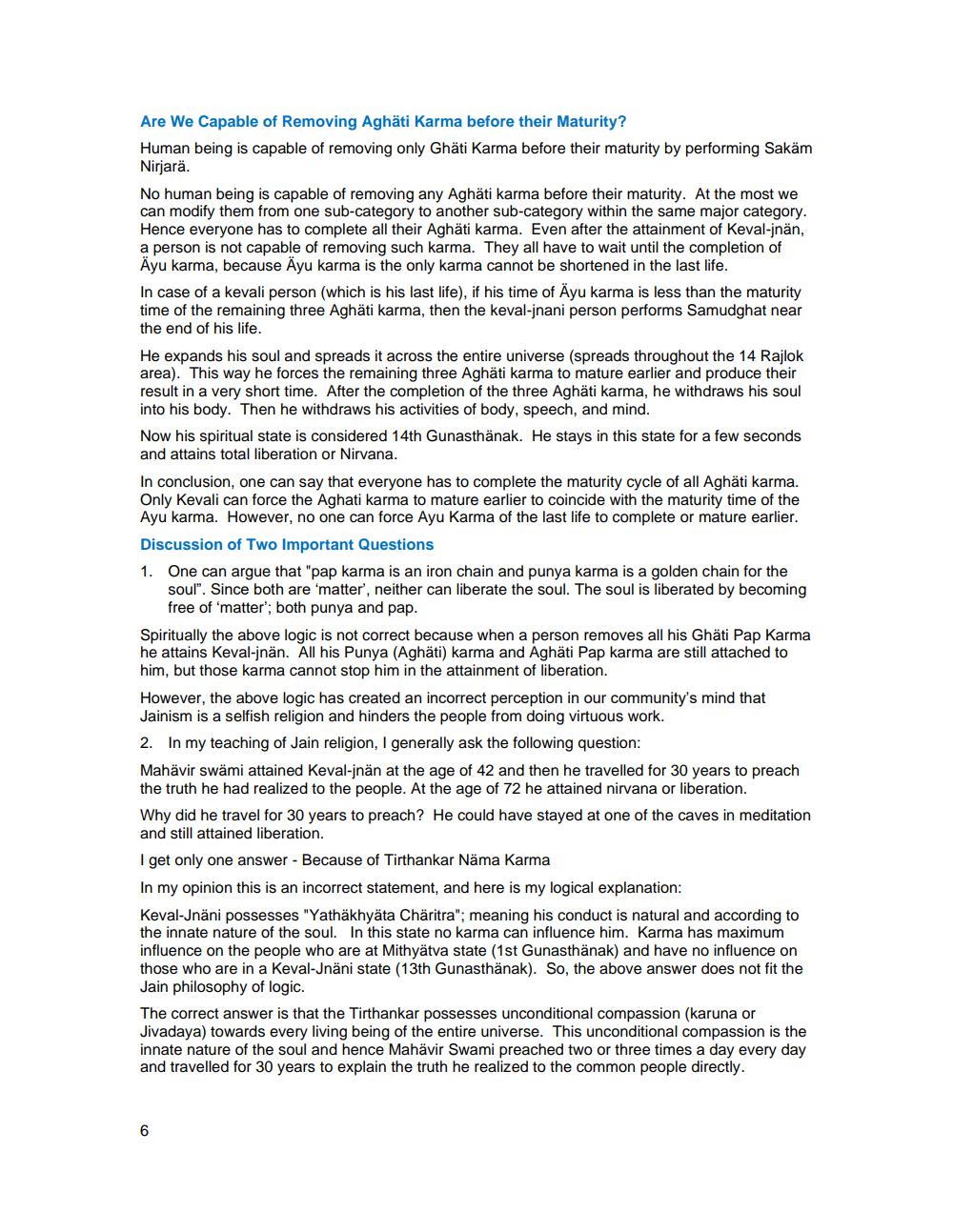________________ Are We Capable of Removing Aghati Karma before their Maturity? Human being is capable of removing only Ghati Karma before their maturity by performing Sakam Nirjara. No human being is capable of removing any Aghati karma before their maturity. At the most we can modify them from one sub-category to another sub-category within the same major category. Hence everyone has to complete all their Aghati karma. Even after the attainment of Keval-inan, a person is not capable of removing such karma. They all have to wait until the completion of Ayu karma, because Ayu karma is the only karma cannot be shortened in the last life. In case of a kevali person (which is his last life), if his time of Ayu karma is less than the maturity time of the remaining three Aghati karma, then the keval-jnani person performs Samudghat near the end of his life. He expands his soul and spreads it across the entire universe (spreads throughout the 14 Rajlok area). This way he forces the remaining three Aghati karma to mature earlier and produce their result in a very short time. After the completion of the three Aghati karma, he withdraws his soul into his body. Then he withdraws his activities of body, speech, and mind. Now his spiritual state is considered 14th Gunasthanak. He stays in this state for a few seconds and attains total liberation or Nirvana. In conclusion, one can say that everyone has to complete the maturity cycle of all Aghati karma. Only Kevali can force the Aghati karma to mature earlier to coincide with the maturity time of the Ayu karma. However, no one can force Ayu Karma of the last life to complete or mature earlier. Discussion of Two Important Questions 1. One can argue that "pap karma is an iron chain and punya karma is a golden chain for the soul". Since both are 'matter', neither can liberate the soul. The soul is liberated by becoming free of 'matter'; both punya and pap. Spiritually the above logic is not correct because when a person removes all his Ghati Pap Karma he attains Keval-inan. All his Punya (Aghati) karma and Aghati Pap karma are still attached to him, but those karma cannot stop him in the attainment of liberation. However, the above logic has created an incorrect perception in our community's mind that Jainism is a selfish religion and hinders the people from doing virtuous work. 2. In my teaching of Jain religion, I generally ask the following question: Mahavir swami attained Keval-jnan at the age of 42 and then he travelled for 30 years to preach the truth he had realized to the people. At the age of 72 he attained nirvana or liberation. Why did he travel for 30 years to preach? He could have stayed at one of the caves in meditation and still attained liberation. I get only one answer - Because of Tirthankar Nama Karma In my opinion this is an incorrect statement, and here is my logical explanation: Keval-Jnani possesses "Yathakhyata Charitra"; meaning his conduct is natural and according to the innate nature of the soul. In this state no karma can influence him. Karma has maximum influence on the people who are at Mithyatva state (1st Gunasthanak) and have no influence on those who are in a Keval-Jnani state (13th Gunasthanak). So, the above answer does not fit the Jain philosophy of logic. The correct answer is that the Tirthankar possesses unconditional compassion (karuna or Jivadaya) towards every living being of the entire universe. This unconditional compassion is the innate nature of the soul and hence Mahavir Swami preached two or three times a day every day and travelled for 30 years to explain the truth he realized to the common people directly.




